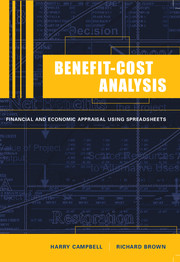Book contents
- Frontmatter
- Contents
- List of figures
- List of tables
- Preface
- Acknowledgements
- 1 Benefit-Cost Analysis: Introduction and Overview
- 2 Investment Appraisal: Principles
- 3 Investment Appraisal: Decision-Rules
- 4 Private Benefit-Cost Analysis: Financial Analysis
- 5 Efficiency Benefit-Cost Analysis
- 6 Calculating the Net Benefits to the Referent Group
- 7 Consumer and Producer Surplus in Benefit-Cost Analysis
- 8 Valuing Traded and Non-traded Commodities in Benefit-Cost Analysis
- 9 Incorporating Risk in Benefit-Cost Analysis
- 10 The Social Discount Rate, Cost of Public Funds, and the Value of Information
- 11 Weighting Net Benefits to Account for Income Distribution
- 12 Valuation of Non-marketed Goods
- 13 Economic Impact Analysis
- 14 Writing the Benefit-Cost Analysis Report
- Appendix 1 Case Study Assignment
- Appendix 2 Discount and Annuity Tables
- Index
8 - Valuing Traded and Non-traded Commodities in Benefit-Cost Analysis
Published online by Cambridge University Press: 05 September 2012
- Frontmatter
- Contents
- List of figures
- List of tables
- Preface
- Acknowledgements
- 1 Benefit-Cost Analysis: Introduction and Overview
- 2 Investment Appraisal: Principles
- 3 Investment Appraisal: Decision-Rules
- 4 Private Benefit-Cost Analysis: Financial Analysis
- 5 Efficiency Benefit-Cost Analysis
- 6 Calculating the Net Benefits to the Referent Group
- 7 Consumer and Producer Surplus in Benefit-Cost Analysis
- 8 Valuing Traded and Non-traded Commodities in Benefit-Cost Analysis
- 9 Incorporating Risk in Benefit-Cost Analysis
- 10 The Social Discount Rate, Cost of Public Funds, and the Value of Information
- 11 Weighting Net Benefits to Account for Income Distribution
- 12 Valuation of Non-marketed Goods
- 13 Economic Impact Analysis
- 14 Writing the Benefit-Cost Analysis Report
- Appendix 1 Case Study Assignment
- Appendix 2 Discount and Annuity Tables
- Index
Summary
Introduction
A project undertaken in an open economy may result in changes in the flows of goods and services which are exported or imported. It is not important whether the actual output of the project is exported, or the actual inputs imported. If the output is a traded commodity (a commodity which the country exchanges in international trade) it may be exported or it may replace imports; similarly, if the inputs are traded commodities they may be imported or they may come from domestic sources which are replaced by increased imports or reduced exports. The changes in international trade flows resulting from the project need to be valued, and the prices which measure the benefit or cost to the economy of changes in exports or imports are international prices.
Projects which involve outputs or inputs of traded commodities are likely also to involve outputs and inputs of non-traded commodities (goods and services which are not involved in the country's international trade), and these non-traded commodities are valued at domestic prices. The benefit-cost analysis of such projects requires comparisons of values of traded and non-traded goods. This poses two problems: first, since traded good prices are denominated in foreign currency (often US$) and non-traded good prices are denominated in domestic currency, an exchange rate is required to convert from one to the other; and, second, the domestic price structure differs from the international price structure, and benefits and costs must be valued under the same price structure if they are to be compared.
Traded and Non-traded Goods
We start this discussion of the distinction between traded and non-traded goods by considering a broader distinction mdash; that between tradeable and non-tradeable goods.
- Type
- Chapter
- Information
- Benefit-Cost AnalysisFinancial and Economic Appraisal using Spreadsheets, pp. 177 - 193Publisher: Cambridge University PressPrint publication year: 2003



